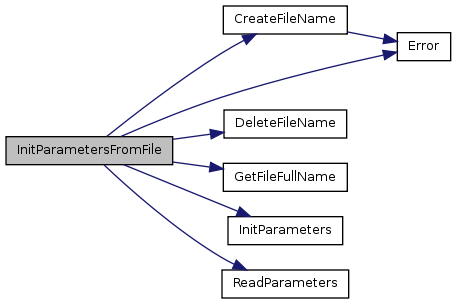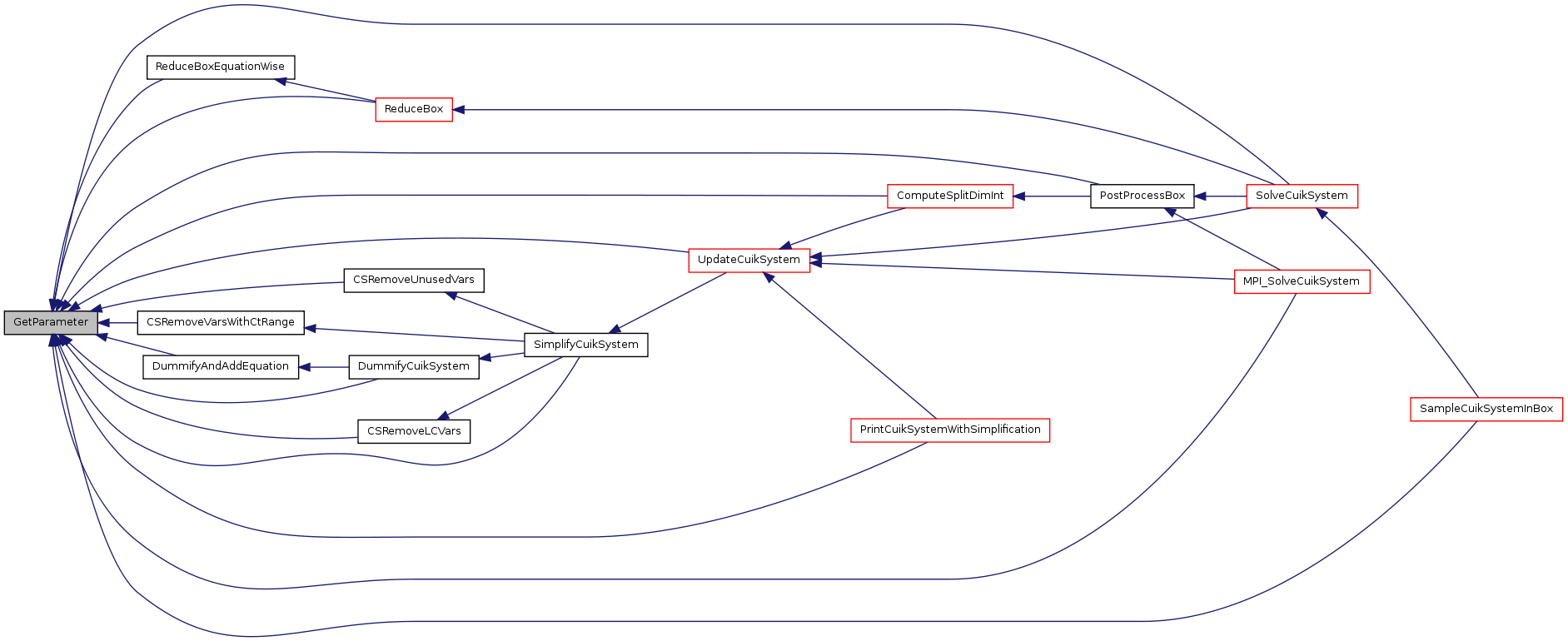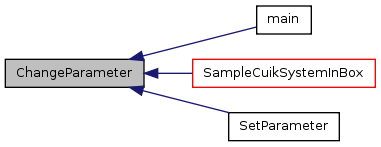

|
|
|
parameters.h File ReferenceDefinition of the Tparameters type and the associated functions. More... #include <stdio.h>Go to the source code of this file.
Detailed DescriptionDefinition of the Tparameters type and the associated functions.
Definition in file parameters.h. Define Documentation
Default file of parameters. This is the file of parameters read in the first place, before reading the file specific for the problem at hand. In this way, the problem specific parameter need only to include values for the parameters whose value is not to be the default value. Definition at line 24 of file parameters.h. Referenced by InitParametersFromFile().
Threshold to turn any number into 0 before passing it to the simplex. This should be larger than 1e-6, the threshold hard-coded in many simplex packages. Definition at line 33 of file parameters.h. Referenced by ComputeSplitDimInt(), CSRemoveLCVars(), CSRemoveUnusedVars(), CSRemoveVarsWithCtRange(), DummifyAndAddEquation(), DummifyCuikSystem(), ReduceBox(), ReduceBoxEquationWise(), SampleCuikSystemInBox(), SimplifyCuikSystem(), and UpdateCuikSystem().
If boxes reduce more that RHO the reduction process is repeated. Definition at line 40 of file parameters.h. Referenced by ReduceBox(), and ReduceBoxEquationWise().
Size of the boxes bounding isolated solutions. Size of the boxes close to obtacles. Definition at line 49 of file parameters.h. Referenced by ReduceBox(), ReduceBoxEquationWise(), and SampleCuikSystemInBox().
Size of the boxes bounding continuous solution sets. Size of the boxes in collision-free areas. Definition at line 57 of file parameters.h. Referenced by PostProcessBox(), and ReduceBox().
Period between two consecutive savings of the internal cuik state. Definition at line 64 of file parameters.h. Referenced by MPI_SolveCuikSystem(), and SolveCuikSystem().
Dummification level.
Definition at line 77 of file parameters.h. Referenced by DummifyAndAddEquation(), DummifyCuikSystem(), and main().
TRUE to use a linearization error minimization criterion to select the split dimension. FALSE to split along the largest side. Definition at line 84 of file parameters.h. Referenced by ComputeSplitDimInt(), and SampleCuikSystemInBox().
Trade off between speed and numerical stability when using the simplex Possible values are
Definition at line 96 of file parameters.h. Referenced by ReduceBox().
Simplification level:
The less the simplification the more the numerical stability, but the slower the solution process. A simplification level 2 should be Ok except for extremely ill conditioned cases. Definition at line 116 of file parameters.h. Referenced by CSRemoveLCVars(), PrintCuikSystemWithSimplification(), and SimplifyCuikSystem().
Threshold to switch from a specific linearization (one based on linear relaxations) to a general one (based on Taylorm models) for purely quadratic equations: parabolas, circles, and spheres. Definition at line 127 of file parameters.h. Referenced by ReduceBox().
Threshold to switch from a specific linearization (one based on linear relaxations ) to a general one (based on Taylorm models) for saddle equations. Definition at line 136 of file parameters.h. Referenced by ReduceBox().
Total number of parameters. Definition at line 143 of file parameters.h. Referenced by ChangeParameter(), GetParameter(), InitParameters(), PrintParameters(), and SetParameter(). Typedef Documentation
A set of parameters. Each parameter is identified with a constant defined in file parameters.h. This is basically a set of constants, but only a small, predefined set of constants are allowed. This is why we do not re-use Tconstants but provide a different implementation.
Definition at line 178 of file parameters.h. Function Documentation
Defines an empty set of parameters.
Definition at line 36 of file parameters.c. References NPARAMETERS. Referenced by InitParametersFromFile().
Here is the caller graph for this function:

Defines an set of parameters from a file. It first read the default set of parameters and then the given set of parameters.
Definition at line 50 of file parameters.c. References CreateFileName(), DEFAULT_PARAMS, DeleteFileName(), Error(), GetFileFullName(), InitParameters(), PARAM_EXT, and ReadParameters(). Referenced by main().
Here is the call graph for this function:

Here is the caller graph for this function:

Gets the value for a particular parameter.
Definition at line 76 of file parameters.c. References Error(), and NPARAMETERS. Referenced by ComputeSplitDimInt(), CSRemoveLCVars(), CSRemoveUnusedVars(), CSRemoveVarsWithCtRange(), DummifyAndAddEquation(), DummifyCuikSystem(), MPI_SolveCuikSystem(), PostProcessBox(), PrintCuikSystemWithSimplification(), ReduceBox(), ReduceBoxEquationWise(), SampleCuikSystemInBox(), SimplifyCuikSystem(), SolveCuikSystem(), and UpdateCuikSystem().
Here is the call graph for this function:

Here is the caller graph for this function:

Sets the name and value for a particular parameter.
Definition at line 93 of file parameters.c. References ChangeParameter(), Error(), and NPARAMETERS.
Here is the call graph for this function:

Sets the value for a particular parameter.
Definition at line 112 of file parameters.c. References Error(), NEW, and NPARAMETERS. Referenced by main(), SampleCuikSystemInBox(), and SetParameter().
Here is the call graph for this function:

Here is the caller graph for this function:

Writes a parameter set to a stream, that can be stdout.
Definition at line 133 of file parameters.c. References NPARAMETERS. Referenced by main().
Here is the caller graph for this function:

Deletes a set of parameters and frees the allocated memory.
Definition at line 152 of file parameters.c. Referenced by main().
Here is the caller graph for this function:
 | |||||||||||||||||||||||||||||||||||||||||||||||||||||||||||||||||||||||||||||||||||||||||||||||||||||||||||||||||||||||||||||||||||||||||||||||||||||||||||||||||||||||||||||||||||||||||||||||||||||||||||||||||||||||||||||||||||||||||||||||||||||||